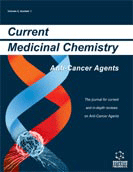Abstract
Anthracycline antibiotics play an important role in cancer chemotherapy. The need for an improvement of their therapeutic index has stimulated an ongoing search for anthracycline analogues with improved properties. Analogue development was originally limited by a lack of information on the cellular drug target, nevertheless almost 20 years ago the mechanism of action of doxorubicin and daunorubicin was revealed and DNA topoisomerase II was recognised to be their main cellular target. Several anthracyclines interfere with topoisomerase II functions by stabilizing a reaction intermediate in which DNA strands are cut and covalently linked to tyrosine residues of the enzyme. Investigations on the sequence specificity of doxorubicin in vitro and in nuclear chromatin of living cell have led to a molecular model of drug receptor on the topoisomerase II-DNA complex. Anthracyclines are likely placed at the interface between the DNA cleavage site and the active site of the enzyme, forming a DNA-drug-enzyme ternary complex. Moreover, a quite detailed structure-function relationship has been established for anthracyclines. First, drug intercalation is necessary but not sufficient for topoisomerase II poisoning; second, the removal of the 4-methoxy and 3-amino substituents greatly increases the drug activity and third, the 3 substituent of the sugar moiety markedly influences the sequence selectivity of anthracycline-stimulated DNA cleavage. These relationships have been exploited during the last decade by several groups, including ours, in the search for new anthracycline drugs with lower side effects and higher activity against resistant cancer cells. This review will focus on areas of the anthracycline field including synthesis of new analogues, new strategies of synthesis and recent developments in the area of drug delivery.
Keywords: anthracyclines, cancer, celluar drug target, topoisomerase II, methoxy, amino substituents, anthracycline cytotoxicity, men, oligosaccharidemodfied analogues, dna topisomerase, monosaccharide anthracyclines
 10
10

















